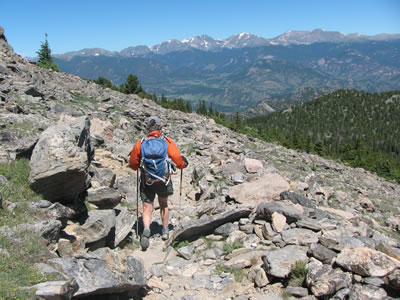| 289 | Hiking Skills - Pace Part Two |
2010-10-04 |

From last Monday's episode Hiking Skill - Pace, we pointed out a few factors which influence pace - goals, fitness, the trail itself, pack weight, clothing, etc. We have to adjust our pace to the conditions to be able to maintain consistency throughout the day.
Through the years we have walked with many different hikers and watched many others. We discuss walking styles and habits as we are walking. Here are a few we have met each with their own style of pace:
Teenager Pace - They start from the trailhead walking as fast as they can go. In a few minutes they will be stopped resting asking, "what took you so long?" They have no rhythm, pace, or endurance. They are not patient. Of course, not only teenagers walk the Teenager Pace.
Football Player Pace - Their pace is very similar to the teenager pace in that they want to move fast and then rest. The major difference is in the Football Player Pace wants to huddle up at every rest stop. They not only want to rest; but they want you to also join their huddle. The football player also likes to carry a heavy pack and grunt.
Racer Pace - The Racer goes as fast and as far as possible and then crashes. They stop, shut down, whether they are at the finish line or not. They are always out in front or trying to pass people trying to be in front. Most racers pass you early on in the hike and you return the favor later in the day.
Engineer Pace - The Engineers pace is slow and methodical. Each step is analyzed. If something is hard they solve the problem. Time is not of the essence, perfection is. How can they be the perfect hiker? The Engineer tends to worry about the ease of movement and not the pace. They will gladly take ten steps where two are all that is required. They understand efficiency; but lose sight of the speed and pace.
Weight Lifters Pace - Almost the exact opposite of the Engineer, the Weight Lifters Pace moves too aggressively using long strides and powering over obstacles. They waste energy. Instead of using a switch back they want to power up the slope, well, until they lose their limited strength.
None of these pacers hike at a steady rate. Bad style is not the end of the world; but the hikers arrive at their destinations exhausted. Of all the hikers the Engineers are closest to setting a good pace; but they are capable of finding ways of making a two hour hike, two or three times as long.
So how do you set a good pace..
- Practice, put in the miles.
- The old adage is - start slow and then slow down. We generally start slow and then speed up as the day progresses. We are always accessing the miles to go, terrain the miles cover, and our strength.
- Don't be influenced by the pace of anyone outside of your group. Don't try to keep up with someone passing you. It is not a race.
- Within your group, do not try to walk fast just because everyone else is, let the leader know the pace is too fast. I have to tell my wife that all of the time!
- Walk in balance.
- Practice to learn your rate of speed. Walk a set course and check your time. Vary the course to different terrains and continue to check your time. Know what it feels like to walk two miles an hour, two and a half miles an hour, and one mile an hour. Knowing your speed also helps with navigation.
- Adjust your speed as the terrain changes. Your rate of steps per minute should stay close to the same, make adjustments to your stride. It is similar to riding a bicycle, your cadence stays the same; but you change gears to match the resistance.
- Practice your cadence. If I find myself slowing down (and it is not fitness related) I count steps to re-center my pace. Once my speed is adequate, I let my mind return to it's wandering ways.
- Be an efficient hiker. Saving energy helps you maintain a good pace.
- Practice good navigation. Know where you are and where you are going. Taking a wrong turn is as wasteful as anything you could possibly do.
- Don't take breaks! Once you leave the trailhead after twenty minutes or so, a break is needed to readjust clothes, retie shoes, readjust whatever. Keep the break to a minimum and continue walking. Keep things you might need while walking close at hand. For example - food and snacks in an easily accessible pocket, water in a hydration bladder, map in a side pocket, hat stowed within reach. The trick is multi-tasking - without falling and busting it. You can't get there unless you keep moving.
- When you take breaks limit the time stopped. If you packed properly, everything should be easy to locate and to re-store.
- So I said do not take breaks and limit the time of breaks, what gives? Ideally, try to limit breaks to destinations. As you are walking when you get to a location that you have to experience - it is time for a break. After all that is why we hike. Breaks will slow you down because of the time stopped and the time required to regain your pace.
Mileage, balance, and pace all help you become a better hiker. Our goal is to arrive at our destination with energy to spare. We are not exhausted; instead we are ready for the camp or other chores and ready for the next day. Next week we will continue the series with Hiking Skills - Stride.
Happy paced trails.
